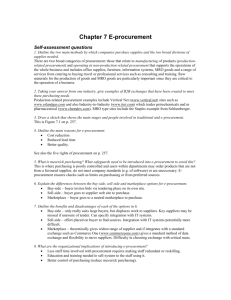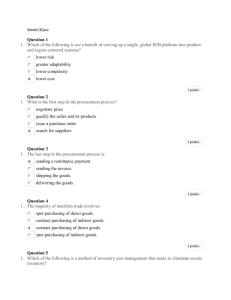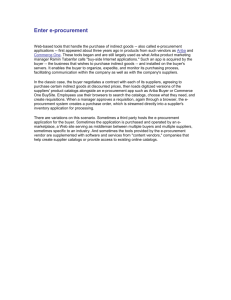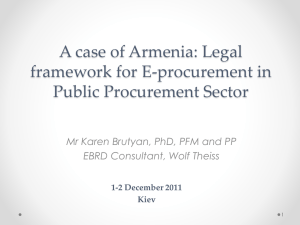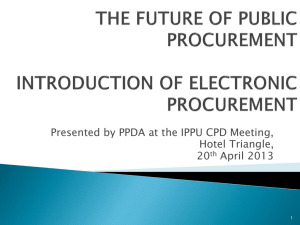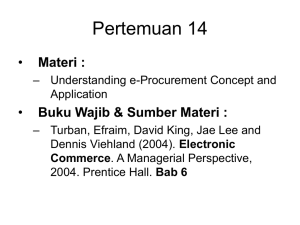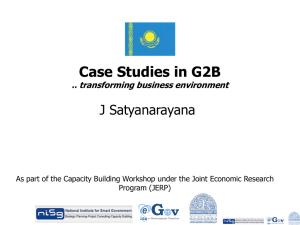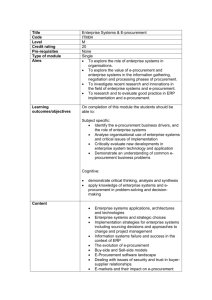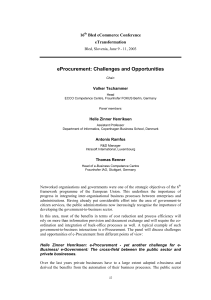Faculty of Science and Technology PhD proposal on The
advertisement
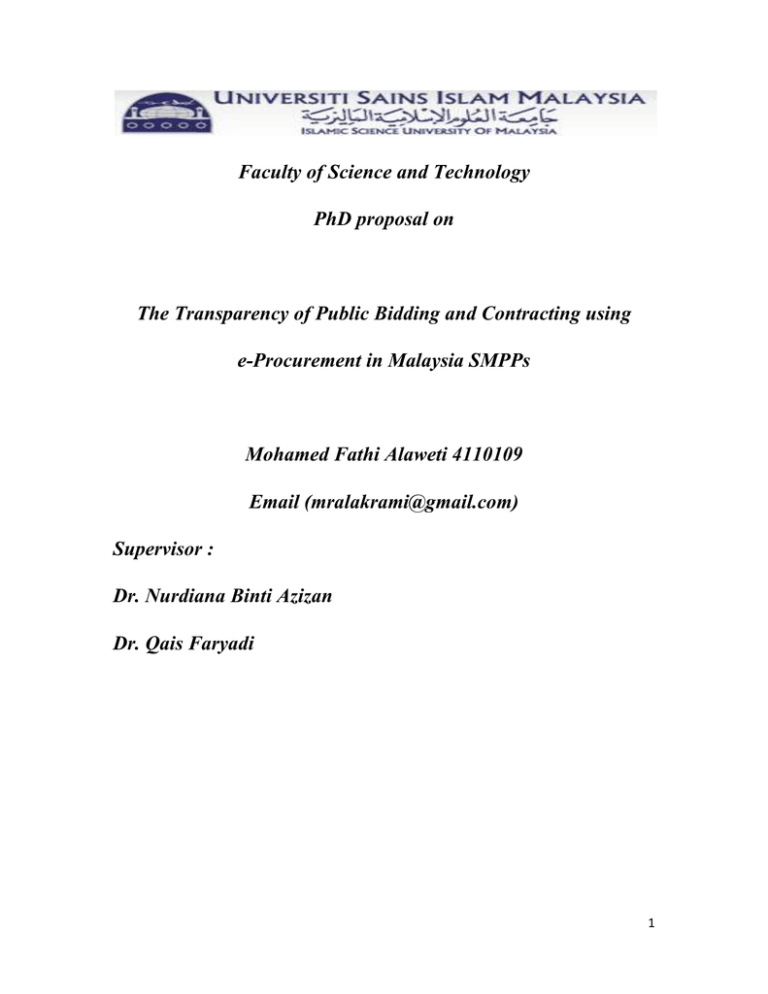
Faculty of Science and Technology PhD proposal on The Transparency of Public Bidding and Contracting using e-Procurement in Malaysia SMPPs Mohamed Fathi Alaweti 4110109 Email (mralakrami@gmail.com) Supervisor : Dr. Nurdiana Binti Azizan Dr. Qais Faryadi 1 ABSTRACT E-procurement has been recognized as an electronic acquisition of goods and services in organizations. Before decades ago the development in e-procurement was limited and took little attention by researchers. Nowadays e-procurement becomes an essential part in most of public bidding in developing countries like China, Australia, U.S.A and Great Britain. This research focuses on implementation e-procurement system in government agencies in Malaysia and critical success factors that improving the transparency level of public bidding and contracting by utilizing the advantages of e-procurmeent technology in ensuring efficient evaluation of bid and tendering process for small medium public projects (SMPP). The purpose of the research is to find the right way for installing electronic tendering systems of e-procurement systems in government agencies in Malaysia in order to increase the level of public bidding transparency amongst (SMPP). Data collection of this research will be obtained from utilizing a set of three methodologies (Descriptive- Qualitative- Correlational Analyses) in order to increase the reliability of the study hypothesis and the precision of study solution a research questionnaire will be submitted to the managers and officials in major Malaysia government which are associated with procurement and public projects. The result of the research tries to provide recommendation about future intention of electronic tendering systems of e-procurement in Malaysian government agencies amongst (SMPP). Keywords Procurement, e-procurement, Transparency, small medium public projects (SMPP), Efficiency, Government Agency, Focus Group 2 1. Introduction E-procurement which is also referred as an electronic procurement is business-toconsumer, or a business-to-business, or a Business-to-government purchase and sales of goods. E-procurement process involves sales and business transaction services through the Internet. E-Procurement is more than just a system for making purchases online. A properly implemented system can connect companies and their business processes directly with suppliers while managing all interactions between them. This includes management of correspondence, bids, questions and answers, previous pricing, and multiple emails sent to multiple participants. A good e-procurement system helps a firm organize its interactions with its most crucial suppliers. It provides those who use it with a set of built-in monitoring tools to help control costs and assure maximum supplier performance. It provides an organized way to keep an open line of communication with potential suppliers during a business process. The system allows managers to confirm pricing, and leverage previous agreements to assure each new price quote is more competitive than the last. Small and medium public projects (SMPP) organizations use e-procurement for high transparent contracting and disclosed for the public in most of times to achieve significant benefits such as cost savings and increased efficiency, other advantages faster government procurement process and higher transparency comparing to traditional procurement and tendering ways. All these advantages provide high control over corruption in procurement services and tendering. Well-managed e-procurement helps reduce inventory levels. Knowing product numbers, bid prices and contact points can help businesses close a deal while other suppliers are struggling to gather their relevant data. E-procurement is emerging rapidly in many developed countries internationally. Many established e-procurement projects have been implemented in Singapore, Australia, UK, USA, Australia and European Union. E-Tendering is one of the most popular types of eprocurement and website installed with e-tendering portals provides information about 3 business opportunities listed by different agencies government and private. It includes future and current business opportunities, also transparent details about awarded contracts. Applying e-procurement to list public tenders nowadays is the main government procurement methods applied in developed countries to avoid corruption and also save cost due to high public competitiveness. E-Procurement helps the directors and managers in commercial departments inside government agencies in decision-making process through providing easy access relevant information about each bid and competitors, the awarding process will be very organized and precise using e-procurement. Keeping track all offers and bid will help the decision committees to have better knowledge about theses bids and obtain better pricing which will save a lot of unnecessary costs. E-procurements also help private organizations to focus on their trading partners and contracts. 2 - Literature Review E-procurement technologies have been improving so far. With emerging e-catalog standards, for instance, it is now possible to go beyond the usual keyword product search by using attribute based search engines, including parametric and preference searches, both of which result in better and faster search results (Doring, et al., 2006). A study titles; “Striving for Transparency and Efficiency in e-Government: Procurement Reform through e-Procurement” by Jungwoo Lee, Kang-Tak Oh, Hun Yeong Kwon , 2009 showed that Government procurement consists of three general steps: (1) planning stage where needs are identified, business cases are established, purchase plans are made and bidding documents are developed, (2) formation stage where bids are invited/received and evaluated, due diligence is negotiated and performed, and the contracts are finalized and awarded, and (3) management stage where contracts are actually executed with periodical reviews. Satisfaction levels with the use of the newer e-procurement venues are quite acceptable considering that firms are new lead users and there are no established reference 4 benchmarks for the online buying experience. The highest levels of satisfaction were reported by firms using supplier-administered sell-side e-procurement systems, closed point-to-point EDI systems, and buy-side e-procurement systems. Business practices that encourage successful e-procurement implementation are involving preferred and strategic suppliers in e-procurement planning, selecting e-procurement software and services following the development of a solid business case, and the consolidation of suppliers and procurement contracts. Major obstacles include the lack of standard interchange formats for e-procurement, difficulty in taking spend data from e-commerce driven transactions and connecting it to the rest of purchase transaction data collected through other systems, and internal end user resistance to learn multiple procurement systems. (Rebecca Angeles. 2007, BUSINESS-TO-BUSINESS E-PROCUREMENT CORPORATE INITIATIVE: A DESCRIPTIVE EMPIRICAL STUDY) A study by Wei Jiang, 2010, title: “E-Procurement and Market Evolution: An Evolutionary Game Approach” showed that e-procurement offers significant cost savings both within and between corporations, and provokes efficient competition among suppliers. When the competition is not so fierce to make the e-marketplace formidable, eprocurement is definitely a better choice for both the buyer and the supplier. In the long run, however, it is inevitable that much more efficient competition permeates the Internet arena. The study also found that many practical strategies for making a difference, including a benefit transfer and a downsized strategic network. (Simon Fong and Zhuang Yan, 2008, Design of a Web-based Tendering System for eGovernment Procurement) highlighted that e-Tendering is more than a front-end website on which suppliers are invited and bidding takes place. The study indicated that a large amount of backend processes follow behind the scene in the e-Tendering cycle. In the context of e-Government who is one of the major users of e-Tendering, the back office processes are bureaucratic. 5 (Kishor Vaidya, PhD, A.S.M. Sajeev, Professor, Junbin Gao, Senior, 2009, e-Procurement Assimilation: An Assessment of E -business Capabilities and Supplier Readiness in the Australian Public Sector) This paper highlighted the need to assess the organization's e- Business capability and suppliers’ e-Business readiness for the successful assimilation of e-Procurement. Drawing upon the Resourced-based View of the firm literature, we provided theoretical support for how e-Business capabilities such as authentication, interoperability, legal frameworks, open standards, and security and privacy and also supplier e-Business readiness can impact the transactional and strategic assimilation of e-Procurement. Through automating the tactical processes and workflows associated with purchasing, the firm expects to increase the productivity of its purchasing agents, lower purchase prices of different types of goods and services, streamline the information flow, business processes, and workflows involved in purchasing, eliminate maverick buying (i.e., buying from unauthorized vendors), reduce order fulfillment and processing times, reduce the number of suppliers the firm is dealing with, streamline invoice reconciliation and dispute resolution, reduce the administrative processing cost per purchase order, integrate budgetary controls into the procurement process, minimize human errors in the buying and shipping processes, and monitoring and regulating buying behavior (Turban, et al., 2006). 3. The Research Problem E-procurement initiatives has received significant support from the major developed countries like Australia, France, Singapore and United States, other developed countries s started to plan for applying e-tendering as one of the main types of e-procurement in most of its public contracting and big projects. The previous governments of Malaysia has done many attempts to control the contracting transparency in government agencies, many of the public tenders has been awarded to companies not based on performance or terms and conditions(wan. S, zakaria. A, Md. A, Dayang.H 2011). In recent years, many constructive efforts have been made by the Malaysian government to systematically control the transparency and bidding in (SMPP). Unfortunately until 6 date all previous attempts failed to control this critical success phenomenon. From this point the study will analyze the main advantages of e-procurement and trying critical success factors to build a smooth system of government agencies that prevent successful implementation of electronic bidding systems that provide high level of (SMPP). 4. The Research Objectives 1. To critical investigate the existing public tendering system in Malaysian (SMPP) system and evaluate its strengths and weakness. 2. To identify the problem and obstacles related to the existing tendering system in Malaysian (SMPP). 3. To Finding the right critical success factors to implement the tendering system using e-procurement in Malaysia(SMPP). 5-The Research Questions In order to achieve the objectives of the research, the principal research question is formulated as follows: 1. What is the existing public system in Malaysia (SMPP) ? 2. What are the problems and obstacles related to the existing tendering system in Malaysian (SMPP)? 3. What are the main success factors bodies that are responsible for initiate (SMPP) e-procurement systems? 7 6- The Contribution of the study The research is to find the critical success factors for installing electronic tendering systems of e-procurement systems in government agencies in Malaysia in order to increase the level of public bidding transparency, save cost of (SMPP). The study also will help the government of Malaysia to save huge funds due to awarding contract for non-qualified bidders. The study also aim to help the Malaysian government to measure the critical success factors in order to pave the way for smooth installation of eprocurement systems. The main contribution of this study in increasing the level of transparency and efficiency of public procurement and tendering which save a lot of funds on (SMPP) controlled by government agencies. The findings and results of this study will push forward the efforts to success factors that completely implements e-procurement system in all government agencies in Malaysia. This study will pave the way for further researches on this subject in Malaysia and contribute the economy of Malaysia by saving huge funds that might be wasted on non qualified public bids and inefficient contracting process for (SMPP). 7-Research methodology The results of this research will be obtained from utilizing a set of three methodologies (Descriptive- Qualitative- Correlational Analyses) in order to increase the reliability of the study hypothesis and the precision of study solution. the results should be more than just a one-off finding and be fundamentally repeatable. This precondition is a must to a hypothesis creating itself as an accepted scientific truth. The first methodology will be applied in this study is a descriptive methodology to describes the primary and secondary data collected from the survey and describing the effects of applying e-procurements in Malaysia from different views. The reason for selecting the descriptive methods in this study in order to answers the research questions precisely. The descriptive methodology is an accurate and systematic methodology, however we still need to use another methodology to complement other requirements in this research that can’t be described using the descriptive methodology like the causes for non-transparency in the case of 8 Malaysia. The internal validity can’t be obtained using the descriptive methodology therefore the study will complement the requirement using a second methodology and this will be in the second part of analysis. As the research questionnaire will be submitted to the managers and officials in major government agencies in Malaysia which are associated with procurement and construction projects. The qualitative methodology will be applied to know precisely what government officials believe and think about the implementation of e-procurement in their management systems, qualitative approach draw out causal constructs those managers have in their mind, therefore a focus group approach will be applied for this study, and conducting focus group interview methods due to the efficiency of this methods in knowing the exact thinking of participants (officials and managers). The focus group is essential in this study because it brings several Malaysian official participants into a guided interview that answer the main research questions and to explore the main obstacles that prevent applying e-procurement in government agencies in Malaysia. The approach is highly favorite and widely used in studies related to public opinion and studies. The study will include a selected delegate from particular government agencies to participate in designed interviews. The delegates will be Malaysian officials who are responsible for implementation and development and of e-procurement. Last the Correlation analyses (Cohen et al., 2003). The statistical correlation is very strong in evaluating the strength of the relations between the study variables. This analysis will use the statistical software package SPSS. The correlational analyses will be applied in this study to measure the support /reject hypotheses. In addition to that a test measurement model will be used to verify the internal consistency (Cronbach’s α) and discriminant validity (correlations). 9 8-References 1) European Commission, Linking up Europe: The importanceof Interoperability for e-Government Services Commission Staff Working paper, (2003), Commission of theEuropean Communities: Brussels, Belgium. 2) Bellman, B.R., F. Enterprise Architecture for e-Government. in Electronic Government. (2004) 3) Springer Verlag: Heidelberg et al.governments: Diffusion of e-procurement practices and itsdeterminants. Journal of Public Procurement, (2007) 4) Moore, G. C., & Benbasat, I. (1991). Development of an instrument to measure the perceptions of adopting an information technology innovation. Information SystemsResearch 5) Seong, S. K., & Lee, J. Y. (2004). Developing e-procurement systems: A case study on the government e-procurement systems in KOREA. Public Finance & Management 6) Smiths, S., & Hirschheim, R. (1999). Analyzing information systems evaluation: Another look at an old problem.European Journal of Information Systems 7) Soares-Aguiar, A., & Palma-dos-Reis, A. (2008). Why do firms adopt eprocurement systems? Using logistic regression to empirically test a conceptual model. IEEE Transactions and Engineering Management 8) Thompson, R. L. et al. (1991). Personal computing: Toward a conceptual model of utilization. MIS Quarterly 9) Tornatzky, L. G., & Fleischer, M., (1990). The process of technological innovation. Lexington Book, Toronto. 10) Vaidya, K. et al. (2006). Critical factors that influence eprocurement implementation success in the public sector. Journal of Public Procurement 10 11) Venkantesh, V. et al. (2003). User acceptance of information technology: Toward a unified view. MIS Quarterly 12) Panayiotou, N. A., Gayialis, S. P., &Tatsiopoulos, I. P. (2004). An e-procurement system for governmental purchasing. International Journal of Production Economics 13) “Electronic Government Procurement (e-GP), Readiness Self Assessment” The Asian Development Bank, The Inter- American Development Bank and The World Bank, (November, 2004). 14) “Methodology for Assessment of National Procurement Systems” (Based on Indicator from OECD-DAC/World bank Round Table), (Version 4, July 17, 2006). 15) Reddick, C. G. (2004). The growth of e-procurement in American state governments: A model and empirical evidence. Journal of Public Procurement 16) Rogers, E.M. (2003). Diffusion of innovations, 5th ed, Free Press, Sydney. 17) Sabherwal, R. et al. (2006). Information system success: Individual and organizational determinants. Management Science 18) Mohamad Noor, N.M., Papamichail, K.N., Warboys, B.,Process modelling for online communications in tendering processes, In Proceedings of 29th Euromicro Conference,2003, Sept. 1-6, 2003 19) Ahmad, F., Saman, M.Y.M., Mohamad Noor, N.M., Othman, A., DSS for Tendering Process: Integrating Statistical Single-Criteria Model with MCDM Models, In Proceedings of 2007 IEEE International Symposium on Signal Processing and Information Technology, (2007) 20) Zhuang Y., Fong, S., Shi, M.L., Knowledge oriented negotiation for agent-based B2B electronic commerce, In Proceedings of 2004 IEEE International Conference on e- Technology, e-Commerce and e-Service, (EEE 2004). 11
